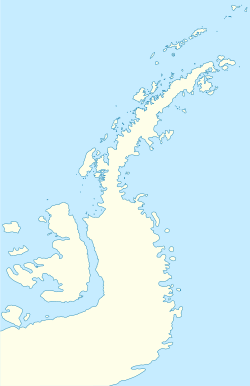Blaiklock Island facts for kids
|
Location in Antarctica
|
|
| Geography | |
|---|---|
| Location | Antarctica |
| Coordinates | 67°33′S 67°4′W / 67.550°S 67.067°W |
| Administration | |
| Administered under the Antarctic Treaty System | |
| Demographics | |
| Population | Uninhabited |
Blaiklock Island is a large, rugged island located in Antarctica. It stretches about 17 kilometres (9 nmi) long. This island sits between two fjords, which are long, narrow inlets of the sea. These are called Bigourdan Fjord and Bourgeois Fjord.
Blaiklock Island is separated from Pourquoi Pas Island by a narrow passage known as The Narrows. It is also separated from the western coast of Graham Land by Jones Channel. In 1936, explorers from the British Graham Land Expedition, led by Rymill, first surveyed this area. At that time, they thought it was a part of the mainland. However, in 1949, Kenneth V. Blaiklock, a surveyor with the Falkland Islands Dependencies Survey (FIDS), discovered it was actually an island. The island was then named after him.
Cool Places on Blaiklock Island
Blaiklock Island has some interesting spots. These places were named by the people who explored and mapped the island.
Scree Cove
Scree Cove is a small bay located on the southwest side of Blaiklock Island. It was mapped by the FIDS team between 1948 and 1959. The cove got its name because of the many "scree" or "talus" slopes found along its southern shore. Scree is a pile of broken rocks that have fallen from a cliff.
Mount Kershaw
Mount Kershaw is a mountain found at the northeast end of Blaiklock Island. It stands tall above an area called Kosiba Wall and where the Jones Ice Shelf used to be.
Blaiklock Island Refuge
The Blaiklock Island Refuge is a small shelter built by the British Antarctic Survey. It is located on the island at 67°32′43″S 67°11′36″W / 67.545189°S 67.193443°W. This refuge was first opened on March 6, 1957. It was used until 1958.
The refuge served as a safe place and a forward base for scientists. They used it for surveys and to study the geology of the area. It also acted as a satellite hut for people working at other research stations nearby, like Station E, Station W, and Station Y.
On May 19, 1995, the refuge was given a special status. It was named a Historic Site or Monument (HSM 63) under the Antarctic Treaty System. This is the same status given to Station Y. The site was cleaned up in 1997. Since 2014, the United Kingdom Antarctic Heritage Trust has been taking care of it.
See also
 In Spanish: Isla Blaiklock para niños
In Spanish: Isla Blaiklock para niños


